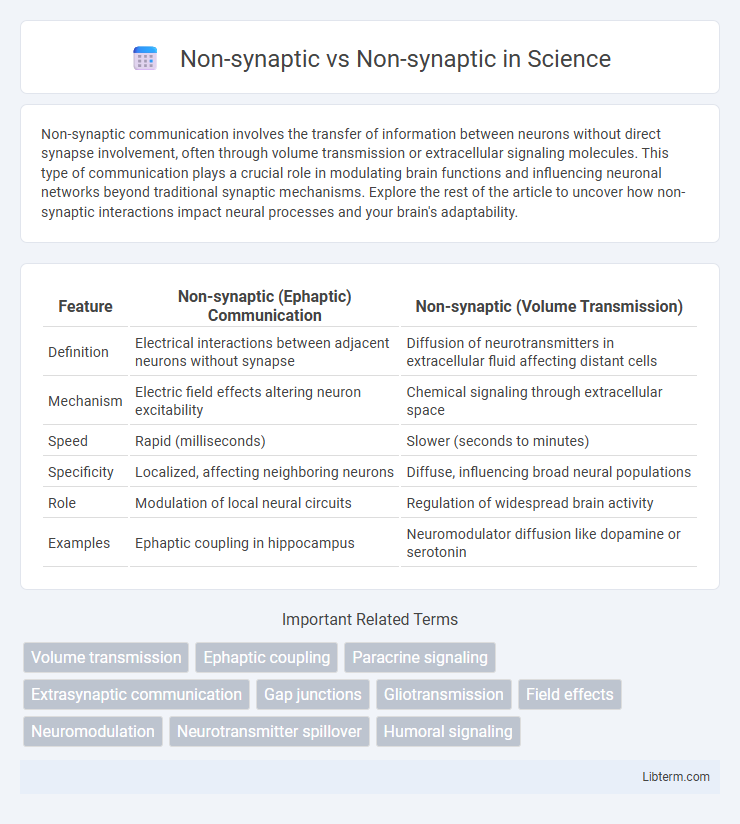Non-synaptic communication involves the transfer of information between neurons without direct synapse involvement, often through volume transmission or extracellular signaling molecules. This type of communication plays a crucial role in modulating brain functions and influencing neuronal networks beyond traditional synaptic mechanisms. Explore the rest of the article to uncover how non-synaptic interactions impact neural processes and your brain's adaptability.
Table of Comparison
| Feature | Non-synaptic (Ephaptic) Communication | Non-synaptic (Volume Transmission) |
|---|---|---|
| Definition | Electrical interactions between adjacent neurons without synapse | Diffusion of neurotransmitters in extracellular fluid affecting distant cells |
| Mechanism | Electric field effects altering neuron excitability | Chemical signaling through extracellular space |
| Speed | Rapid (milliseconds) | Slower (seconds to minutes) |
| Specificity | Localized, affecting neighboring neurons | Diffuse, influencing broad neural populations |
| Role | Modulation of local neural circuits | Regulation of widespread brain activity |
| Examples | Ephaptic coupling in hippocampus | Neuromodulator diffusion like dopamine or serotonin |
Introduction to Non-synaptic Communication
Non-synaptic communication involves the transmission of signals between neurons without the use of traditional synapses, relying instead on mechanisms like volume transmission and extracellular diffusion of neurotransmitters. This mode of neural communication allows for broader and slower signaling compared to synaptic transmission, influencing multiple neurons simultaneously. Non-synaptic signaling plays a critical role in modulating neural networks and maintaining homeostasis in the central nervous system.
Defining Synaptic and Non-synaptic Transmission
Synaptic transmission involves the release of neurotransmitters across a synaptic cleft, enabling precise, targeted communication between neurons with defined postsynaptic receptors. Non-synaptic transmission, also known as volume transmission, occurs when neurotransmitters diffuse through the extracellular fluid to influence multiple neurons over a broader area without direct synaptic contact. This distinction highlights the spatial and functional differences essential for understanding neural communication mechanisms in both localized and widespread signaling contexts.
Types of Non-synaptic Interactions
Non-synaptic interactions encompass several types including ephaptic coupling, volume transmission, and gap junction communication, each facilitating neuronal communication without traditional synapses. Ephaptic coupling involves electric field effects between adjacent neurons, while volume transmission relies on the diffusion of neurotransmitters through extracellular fluid to affect distant cells. Gap junctions are specialized intercellular connections allowing direct cytoplasmic exchange of ions and small molecules, enabling rapid and coordinated cellular responses.
Mechanisms of Non-synaptic Signaling
Non-synaptic signaling mechanisms involve the diffusion of neurotransmitters or neuromodulators into the extracellular space, affecting target cells far beyond traditional synaptic junctions. Volume transmission enables widespread communication by altering the excitability or functionality of neurons and glial cells through receptor activation independent of synaptic clefts. This process contrasts with synaptic signaling, which relies on direct, point-to-point neurotransmitter release at specialized junctions, highlighting the distinct spatial and temporal dynamics of non-synaptic communication in neural networks.
Non-synaptic vs Synaptic Communication: Key Differences
Non-synaptic communication occurs through diffusion of neurotransmitters or neuromodulators across extracellular space, affecting multiple target cells simultaneously without the precise targeting seen in synaptic communication. In contrast, synaptic communication involves the release of neurotransmitters into a synaptic cleft, enabling fast, specific, and directional signaling between pre- and postsynaptic neurons. Non-synaptic signaling plays a crucial role in modulating overall neural network activity, whereas synaptic transmission is essential for rapid and localized information processing.
Functional Roles of Non-synaptic Transmission
Non-synaptic transmission plays a crucial role in modulating neural activity by facilitating communication through diffusible chemical signals rather than direct synaptic connections. This mode of transmission is essential for coordinating widespread neural networks, influencing processes such as neuromodulation, neuroimmune responses, and volume transmission. It enables neurons and glial cells to regulate excitability and plasticity beyond traditional synaptic boundaries, impacting overall brain function and behavior.
Examples of Non-synaptic Communication in the Nervous System
Non-synaptic communication in the nervous system includes volume transmission where neurotransmitters diffuse through extracellular fluid to affect distant neurons, and ephaptic transmission involving electrical interactions between adjacent nerve fibers without synapses. Examples include the release of neuromodulators such as nitric oxide and neuropeptides that influence widespread areas, as well as gap junctions allowing direct electrical coupling between neurons for rapid signal propagation. These mechanisms complement traditional synaptic signaling by modulating neuronal activity and network dynamics beyond synapse boundaries.
Non-synaptic Plasticity and Adaptation
Non-synaptic plasticity refers to changes in neuronal function that occur independently of synaptic transmission, involving modifications in ion channel density, intrinsic excitability, and membrane properties. This form of plasticity plays a crucial role in neural adaptation by enabling neurons to regulate their responsiveness to stimuli without altering synaptic strength, contributing to homeostatic balance and information processing. Unlike synaptic plasticity, which depends on synaptic efficacy changes such as long-term potentiation or depression, non-synaptic mechanisms ensure stability and flexibility in neural circuits through activity-dependent modulation of intrinsic neuronal properties.
Clinical Implications of Non-synaptic Signaling
Non-synaptic signaling plays a crucial role in modulating neural network excitability and plasticity, influencing conditions such as epilepsy, neuropathic pain, and psychiatric disorders. Unlike synaptic transmission dependent on direct neuron-to-neuron contact, non-synaptic communication involves diffusible factors and ionic changes affecting large populations of neurons, thereby altering clinical outcomes and therapeutic targets. Understanding non-synaptic mechanisms enhances the development of novel interventions aiming to regulate aberrant neural activity beyond traditional synaptic pathways.
Future Perspectives in Non-synaptic Neurobiology
Future perspectives in non-synaptic neurobiology emphasize understanding the role of extracellular vesicles and volume transmission in neural communication beyond traditional synapses. Advances in high-resolution imaging and optogenetic tools will enable the mapping of non-synaptic signaling pathways, revealing novel mechanisms of neuronal plasticity and information processing. This research could lead to innovative therapeutic strategies targeting neurodegenerative diseases and psychiatric disorders by modulating non-synaptic interactions.
Non-synaptic Infographic

 libterm.com
libterm.com